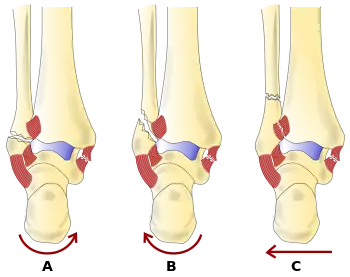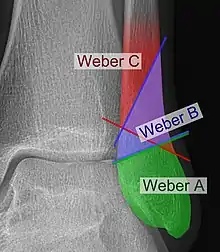Danis–Weber classification
The Danis–Weber classification (often known just as the Weber classification) is a method of describing ankle fractures. It has three categories:[1]
- Type A


Fracture of the lateral malleolus distal to the syndesmosis (the connection between the distal ends of the tibia and fibula). Typical features:
- below level of the ankle joint
- tibiofibular syndesmosis intact
- deltoid ligament intact
- medial malleolus occasionally fractured
- usually stable: occasionally nonetheless requires an open reduction and internal fixation (ORIF) particularly if medial malleolus fractured
- Type B
Fracture of the fibula at the level of the syndesmosis. Typical features:
- at the level of the ankle joint, extending superiorly and laterally up the fibula
- tibiofibular syndesmosis intact or only partially torn, but no widening of the distal tibiofibular articulation
- medial malleolus may be fractured or deltoid ligament may be torn
- variable stability
- Type C
Fracture of the fibula proximal to the syndesmosis. Typical features:
- above the level of the ankle joint
- tibiofibular syndesmosis disrupted with widening of the distal tibiofibular articulation
- medial malleolus fracture or deltoid ligament injury present
- unstable: requires ORIF
Categories B and C imply a degree of damage to the syndesmosis itself (which cannot be directly visualised on X-ray). They are inherently unstable and are more likely to require operative repair to achieve a good outcome. Type A fractures are usually stable and can be managed with simple measures, such as a plaster of paris cast.
See also
References
- Mcrae, Ronald; Esser, Max. Practical Fracture Treatment (Fifth ed.). p. 382. ISBN 978-0-443-06876-8.